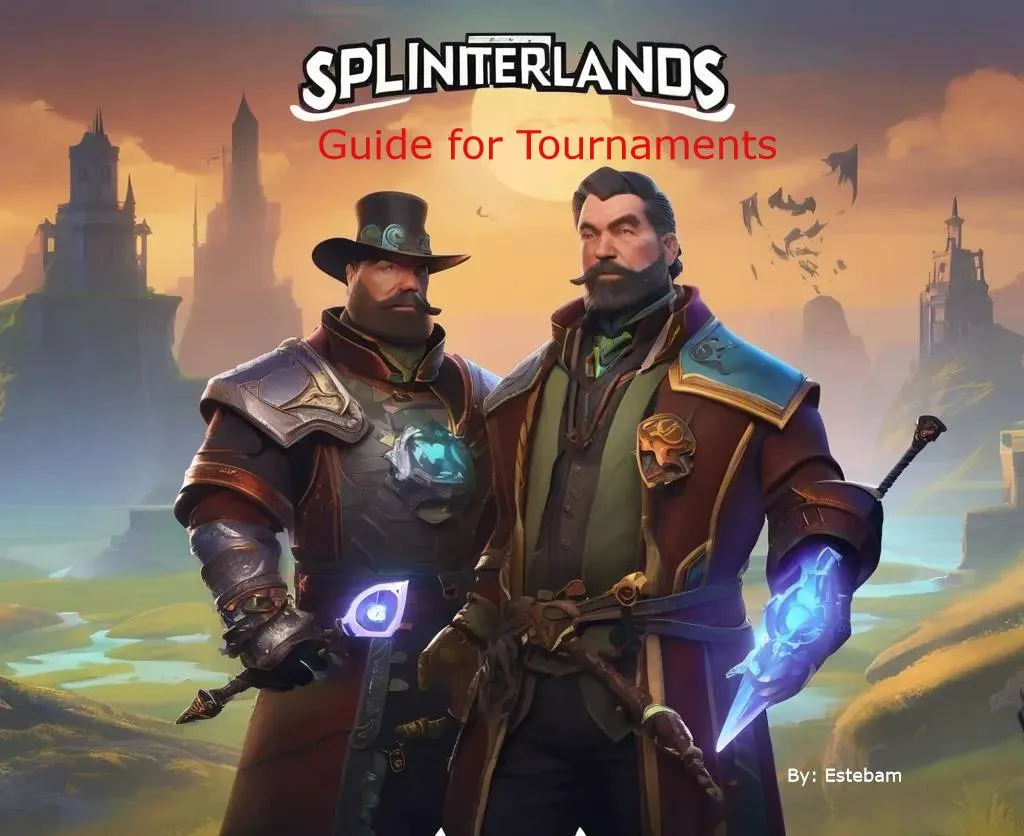
Hey SplinterMates, how are doing? In today´s post I would like to share with you (and specially with the new players) this Splinterlands Tournament Guide.
The Splinterlands team has asked the active members to help creating support articles and this is my contribution🤜🤛.
To all Splinterlands players outside, there are not only Modern/ Wild Ranked battles or Guild Brawls. There are also Tournaments where you can participate, have fun and earn some juicy rewards🤑.
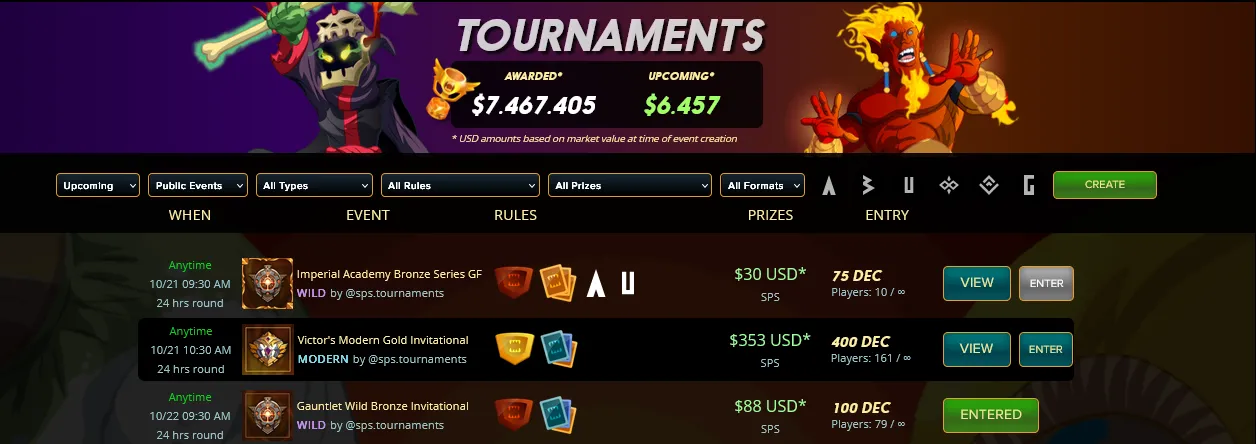
This guide will walk you through everything you need to know about participating in Splinterlands tournaments.
So after having done this small introduction to this weeks challenge, please let me encourage you to participate and create your own post. You can find the article under the following link
1. Understanding Splinterlands Tournaments
Splinterlands tournaments come in different formats and are a great way to test your skills against other players. The main types of tournaments are:
- Open Tournaments: Anyone can join, provided they meet the requirements (e.g., owning certain cards or having a certain collection power).
- Guild Tournaments: Restricted to members of certain guilds.
- Invitation-Only Tournaments: Specific players or groups are invited to participate.

The most common tournaments you will find are open tournaments organized by the Splinterlands team, so you will have a big number of tournaments available for you.
2. Tournament Types and Formats
Formats
There are several formats in Splinterlands tournaments:
- Single Elimination: If you lose a match, you're eliminated from the tournament.
- Double Elimination: You need to lose twice before being eliminated.
- Swiss: You are paired with other players for a set number of rounds, and the winner is determined based on overall performance rather than elimination.
- Round Robin: Every player competes against every other player in the group.
Level Caps
Each tournament may have level caps or restrictions that dictate which cards can be used. Common caps include:
- Novice: Level 1 cards only.
- Bronze: Lower-level cards with limited abilities.
- Silver: Moderate-level cards with more abilities unlocked.
- Gold and Diamond: High-level cards with near or fully unlocked abilities.

Be sure to check the level cap for a tournament, as using cards above the limit can disqualify you.
3. Entry Requirements
One of the key things you should check before entering a tournament are the entry requirements. These can vary significantly based on the type of tournament and its rewards. Common entry requirements include:
- Entry Fees: Some tournaments have fees in DEC, SPS, or VOUCHER tokens.
- Collection Power (CP): A minimum CP may be required to participate in specific tournaments. Collection Power represents the combined value of all your cards.
- Card Editions: Some tournaments restrict players to using cards from specific editions (e.g., Untamed, Chaos Legion).
- Splinter or Set Restrictions: Some tournaments may limit certain splinters (factions) or specific sets of cards. For example, only Earth Splinter or Dragon Splinter cards might be allowed.
4. Preparing for a Tournament
As everything in life, success in Splinterlands tournaments requires careful preparation and a plan:
1. Card Selection
- Balanced Deck: Make sure your deck has a variety of splinters (factions) and strategies.
- Synergies: Look for synergies between cards, focusing on team composition that maximizes buffs, debuffs, and combos.
- Maximized Abilities: Higher-level cards unlock more powerful abilities. Maximize your card levels to fit the tournament's cap.
If you are a new player and you would like to know where to find additional information regarding decks, synergies and meta cards, you can have a look at some of these guys Youtube channels @aftersound, @bulldog1205 or @infidel1258. These guys are amazing and you will learn a lot from them.
2. Practice and analyze opponents
- Ranked Battles: Practice in ranked mode to test your card combinations and refine your strategies. You need to know which are the meta cards and how to combine them. A good way to improve your potential results is to rent some of these cards and start practicing. You can check the rental market and compare rent prices.

- Observe Match History: At the very beginning of your journey in Splinterlands, I strongly recommend you to check each battle you play and understand why your opponent has won the battle. In that way, you get a better knowledge of the game and you can keep learning how the game evolves. Currently, the team is releasing new cards and the game keeps evolving. But don´t worry, if you don´t have enough time to watch the battle, you can do it afterwards by checking the Battle Log.
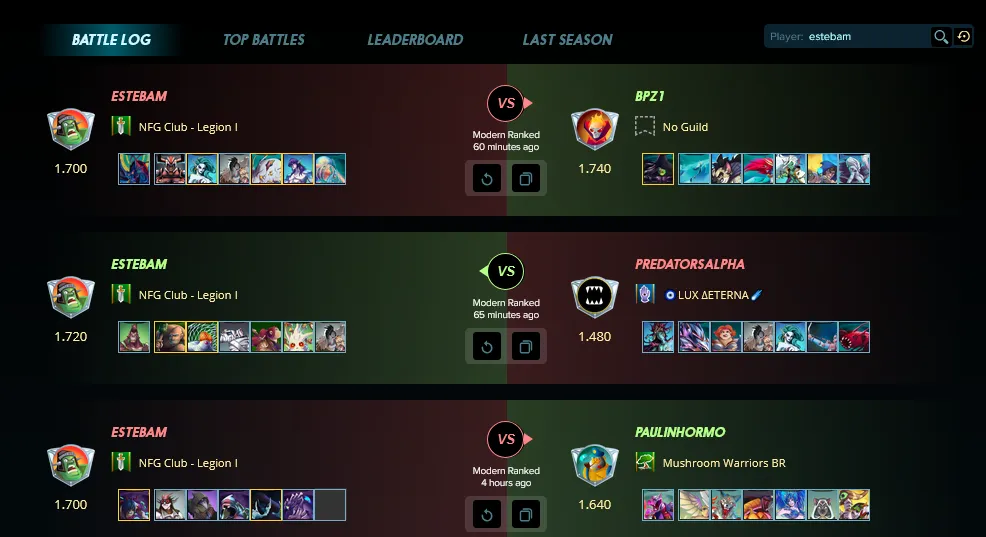
5. Joining and Playing in a Tournament
Step 1: Registering
- Navigate to the "Events" tab in Splinterlands.
- Browse the list of available tournaments and check the details (entry fees, requirements, prize pools).
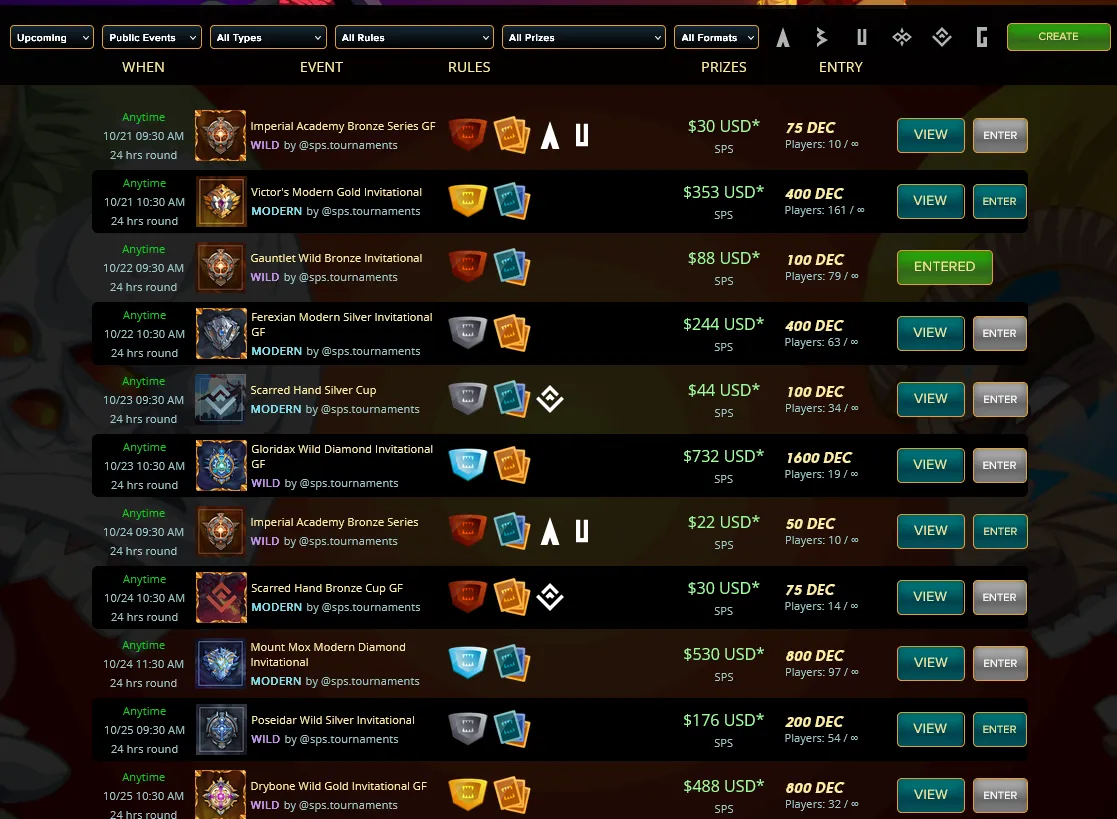
- Pay the entry fee (if required) and register for the tournament.
As an example, below you have a tournament I have joined today.
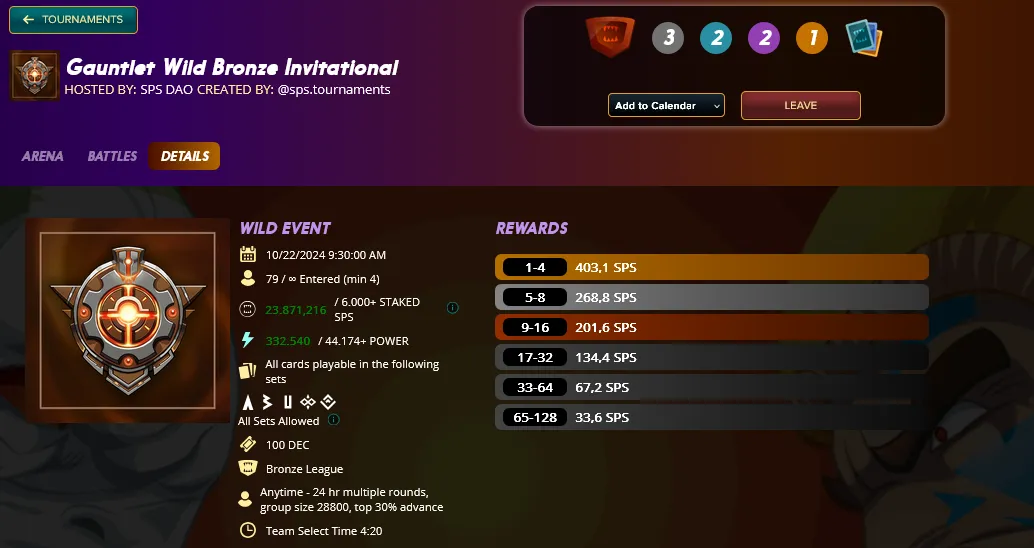
I have joined the Gauntlet Wild Bronze Invitaional event, which had the following entry requirements:
1- +6.000 SPS required.
2- CP +44.174 Power required.
3- All set of cards are allowed.
This event will start on the 22nd October, so I still cannot submit battles or know exactly who I going to battle with. But I can already see the players that have joined the tournament.
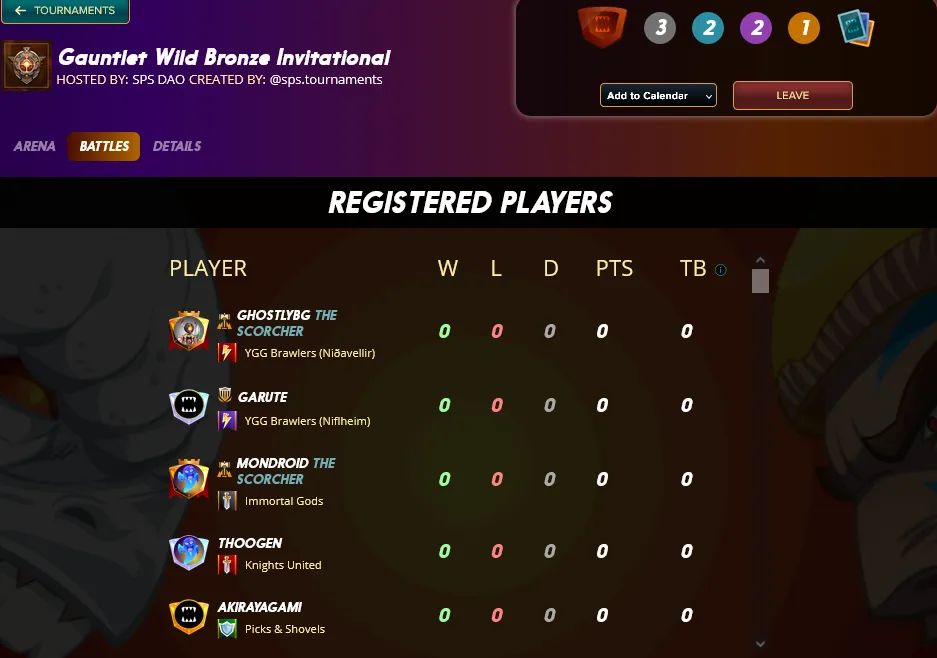
I will update the post in a few days to show you my results and how to submit a battle, but as for now, I will do it in a theoretical way, so you can try it on your own:
Step 2: Pre-Match Setup
- Once the tournament begins, you'll be matched with an opponent, as per a standard battle.
- You’ll receive a battle set of rules (which might include special conditions like fog of war, earthquake, etc.).
- Choose your team based on the rules and splinter options available.
Step 3: Submit Your Team
- You have a limited amount of time to submit your team. Select your summoner, creatures, and placement carefully.
- Once both players submit their teams, the match is simulated. It is important to submit all your battles, because sometimes happens that the enemy doesn´t submit the team and you automatically win the battle.
Step 4: Analyze Results
- As mentioned above, Win or lose, review your battle, watch replays, and analyze what went wrong or right.
6. Tournament Strategy Tips
Adapt to Rulesets: Each tournament match comes with its own set of rules (e.g., only melee attackers, no healing, fog of war). Make sure you adjust your strategy to fit the ruleset.
Understand Mana Cap: Tournaments will give you a different mana cap for each round, dictating how powerful of a deck you can play. Adjust your team according to the mana cap.
Card Synergies: Some cards work better together due to buffs and abilities. For instance, pairing a healer with a tanky frontliner can keep your main damage dealer alive longer.
Watch Your Opponents: If it's a double or Swiss elimination tournament, study your opponents’ teams between rounds. This can give you a clue about how to counter them in future matches.
Budget for Entry Fees: Make sure to enter tournaments that match your skill level and budget. Some tournaments are free, while others may require significant DEC or SPS.
7. Earning Rewards
Splinterlands tournaments can be highly rewarding, especially if you place well. Rewards vary by tournament but often include:
- DEC (Dark Energy Crystals): The in-game currency.
- SPS (Splintershards): The governance token for Splinterlands, used in staking and other in-game features.
- Cards: Rare or exclusive cards are often part of the reward pool.
- Vouchers: Useful for special in-game promotions.
Rewards are usually tiered, meaning higher placements receive more valuable rewards. Even if you don’t win, you may still earn consolation prizes.
8. Advancing Your Tournament Skills
To improve your performance over time:
- Join More Tournaments: Even if you're not ready to win, joining tournaments will give you more experience.
- Participate in Guild Tournaments: Guilds often provide valuable advice and feedback on strategies, so joining an active guild can give you an edge.
- Use Tools and Resources: Utilize third-party tools like Splintercards and PeakMonsters to analyze card prices, stats, and performance in real time.
9. Conclusion
Splinterlands tournaments are exciting opportunities to test your deck-building skills and strategic thinking. By understanding the rules, preparing your deck, and practicing regularly, you can improve your chances of success. Plus, tournaments are an excellent way to earn in-game rewards and become part of the competitive community.
Good luck in your future tournaments, and may the best summoner win!

Please share with me in my comments section if you are going to try some tournaments 🤝and thank you for reading until the end.

If you haven't made an account already, please consider using my referral link to sign up.